Radiographer Student Reflection Report 2022
VerifiedAdded on 2022/10/13
|12
|3386
|19
AI Summary
Contribute Materials
Your contribution can guide someone’s learning journey. Share your
documents today.
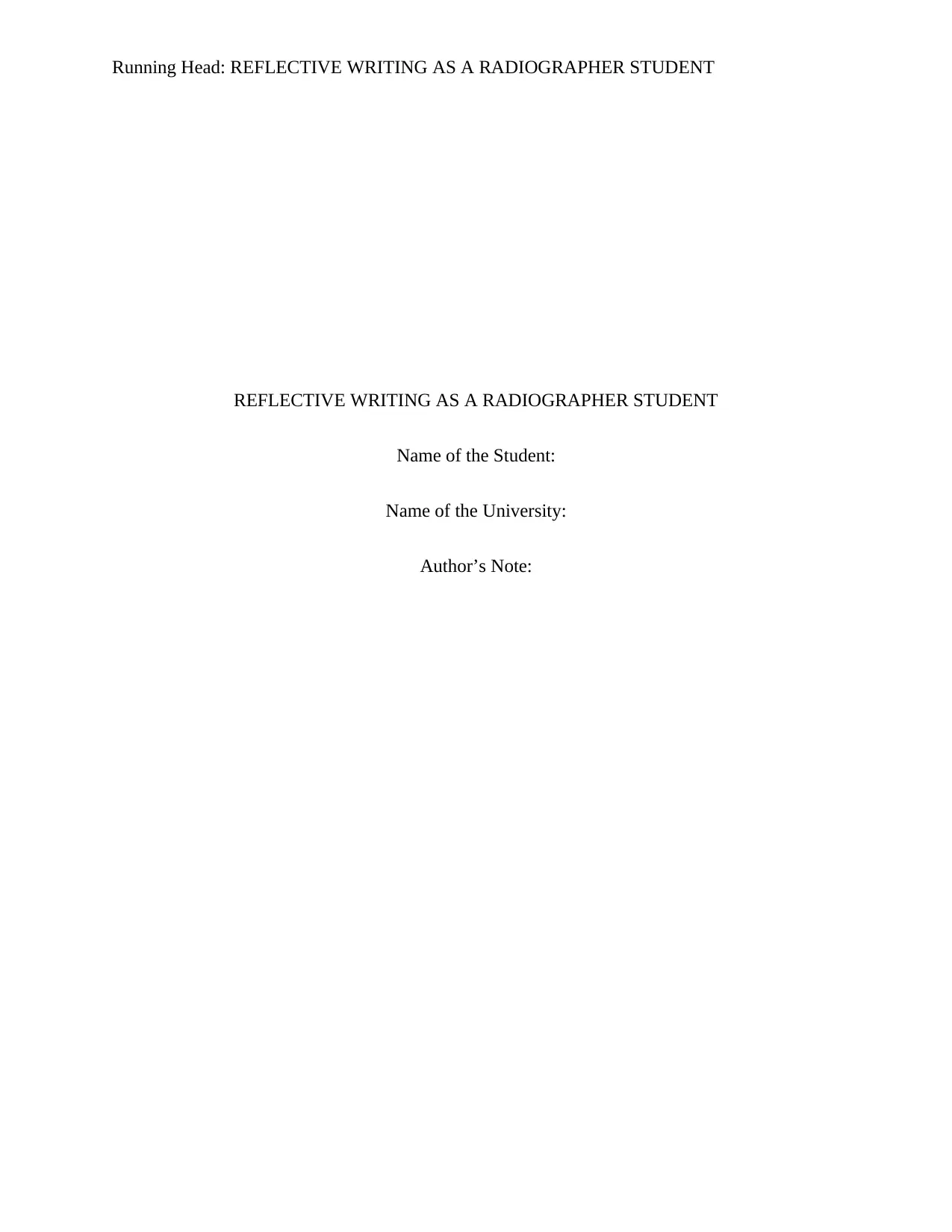
Running Head: REFLECTIVE WRITING AS A RADIOGRAPHER STUDENT
REFLECTIVE WRITING AS A RADIOGRAPHER STUDENT
Name of the Student:
Name of the University:
Author’s Note:
REFLECTIVE WRITING AS A RADIOGRAPHER STUDENT
Name of the Student:
Name of the University:
Author’s Note:
Secure Best Marks with AI Grader
Need help grading? Try our AI Grader for instant feedback on your assignments.
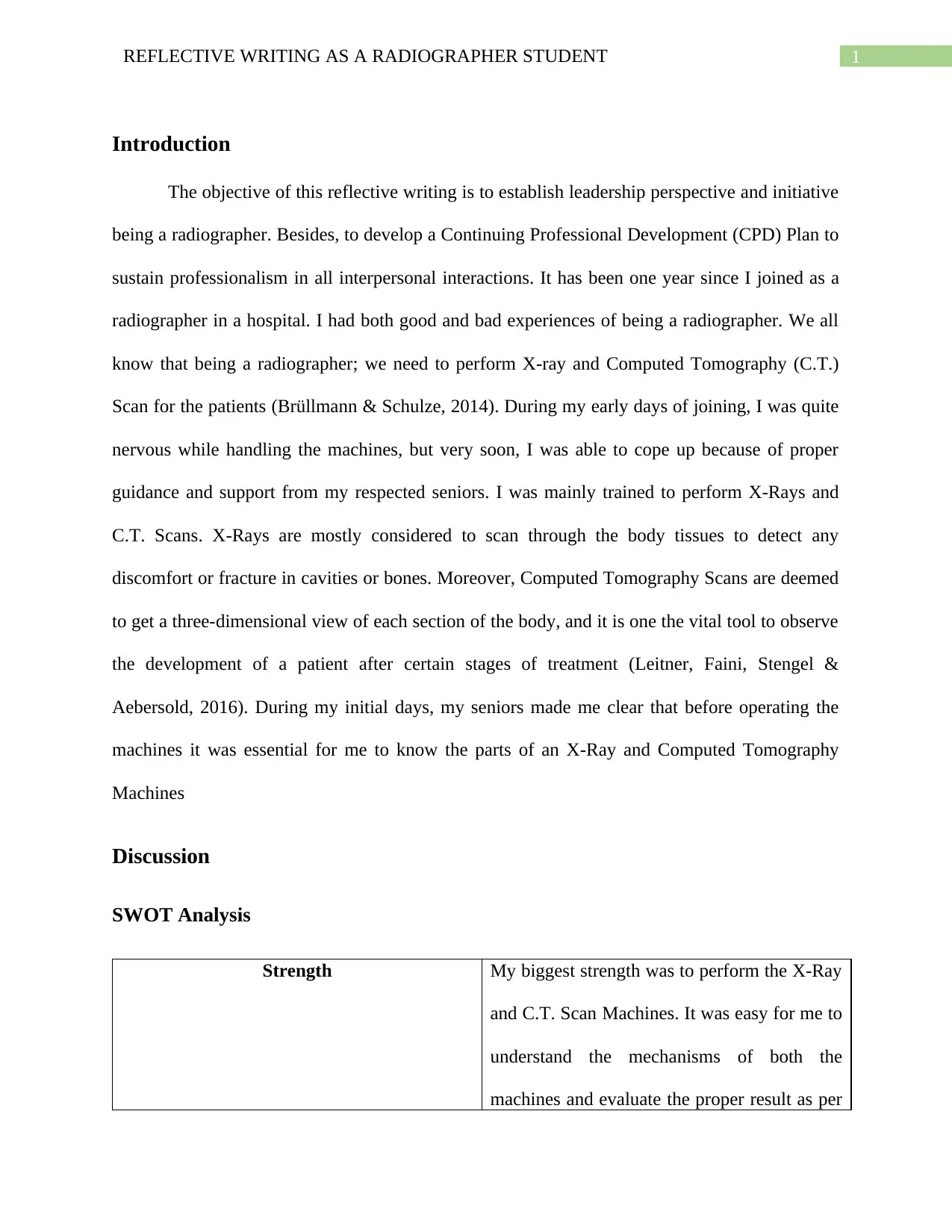
1REFLECTIVE WRITING AS A RADIOGRAPHER STUDENT
Introduction
The objective of this reflective writing is to establish leadership perspective and initiative
being a radiographer. Besides, to develop a Continuing Professional Development (CPD) Plan to
sustain professionalism in all interpersonal interactions. It has been one year since I joined as a
radiographer in a hospital. I had both good and bad experiences of being a radiographer. We all
know that being a radiographer; we need to perform X-ray and Computed Tomography (C.T.)
Scan for the patients (Brüllmann & Schulze, 2014). During my early days of joining, I was quite
nervous while handling the machines, but very soon, I was able to cope up because of proper
guidance and support from my respected seniors. I was mainly trained to perform X-Rays and
C.T. Scans. X-Rays are mostly considered to scan through the body tissues to detect any
discomfort or fracture in cavities or bones. Moreover, Computed Tomography Scans are deemed
to get a three-dimensional view of each section of the body, and it is one the vital tool to observe
the development of a patient after certain stages of treatment (Leitner, Faini, Stengel &
Aebersold, 2016). During my initial days, my seniors made me clear that before operating the
machines it was essential for me to know the parts of an X-Ray and Computed Tomography
Machines
Discussion
SWOT Analysis
Strength My biggest strength was to perform the X-Ray
and C.T. Scan Machines. It was easy for me to
understand the mechanisms of both the
machines and evaluate the proper result as per
Introduction
The objective of this reflective writing is to establish leadership perspective and initiative
being a radiographer. Besides, to develop a Continuing Professional Development (CPD) Plan to
sustain professionalism in all interpersonal interactions. It has been one year since I joined as a
radiographer in a hospital. I had both good and bad experiences of being a radiographer. We all
know that being a radiographer; we need to perform X-ray and Computed Tomography (C.T.)
Scan for the patients (Brüllmann & Schulze, 2014). During my early days of joining, I was quite
nervous while handling the machines, but very soon, I was able to cope up because of proper
guidance and support from my respected seniors. I was mainly trained to perform X-Rays and
C.T. Scans. X-Rays are mostly considered to scan through the body tissues to detect any
discomfort or fracture in cavities or bones. Moreover, Computed Tomography Scans are deemed
to get a three-dimensional view of each section of the body, and it is one the vital tool to observe
the development of a patient after certain stages of treatment (Leitner, Faini, Stengel &
Aebersold, 2016). During my initial days, my seniors made me clear that before operating the
machines it was essential for me to know the parts of an X-Ray and Computed Tomography
Machines
Discussion
SWOT Analysis
Strength My biggest strength was to perform the X-Ray
and C.T. Scan Machines. It was easy for me to
understand the mechanisms of both the
machines and evaluate the proper result as per

2REFLECTIVE WRITING AS A RADIOGRAPHER STUDENT
my observation. There were times when I had
to perform the scans for some patients, and I
did it successfully without any hesitation.
Withy my regular successful attempts, it
helped me to operate the machines with utmost
confidence (Arbab, Spaulding, Gamm &
Johnson, 2014).
Weakness
My biggest weakness was to perform scans for
patients with serious injuries or pains. During
my initial days, it was quite severe for me to
face those patients. I used to get very
emotional because it was not easy for me to
watch them suffering from such severe pain.
During that period, often, I used to get nervous
and feel uncomfortable (MoroVisconti, 2016).
Opportunities As a radiographer, it was essential for me to
know the opportunities that I would be getting
in my further career. I gained good
experiences in operating X-Rays and C.T.
Scans. Therefore, I would be able to contribute
my valuable experiences in either Diagnostic
Radiology that includes X-Ray or
Interventional Radiology that includes
my observation. There were times when I had
to perform the scans for some patients, and I
did it successfully without any hesitation.
Withy my regular successful attempts, it
helped me to operate the machines with utmost
confidence (Arbab, Spaulding, Gamm &
Johnson, 2014).
Weakness
My biggest weakness was to perform scans for
patients with serious injuries or pains. During
my initial days, it was quite severe for me to
face those patients. I used to get very
emotional because it was not easy for me to
watch them suffering from such severe pain.
During that period, often, I used to get nervous
and feel uncomfortable (MoroVisconti, 2016).
Opportunities As a radiographer, it was essential for me to
know the opportunities that I would be getting
in my further career. I gained good
experiences in operating X-Rays and C.T.
Scans. Therefore, I would be able to contribute
my valuable experiences in either Diagnostic
Radiology that includes X-Ray or
Interventional Radiology that includes
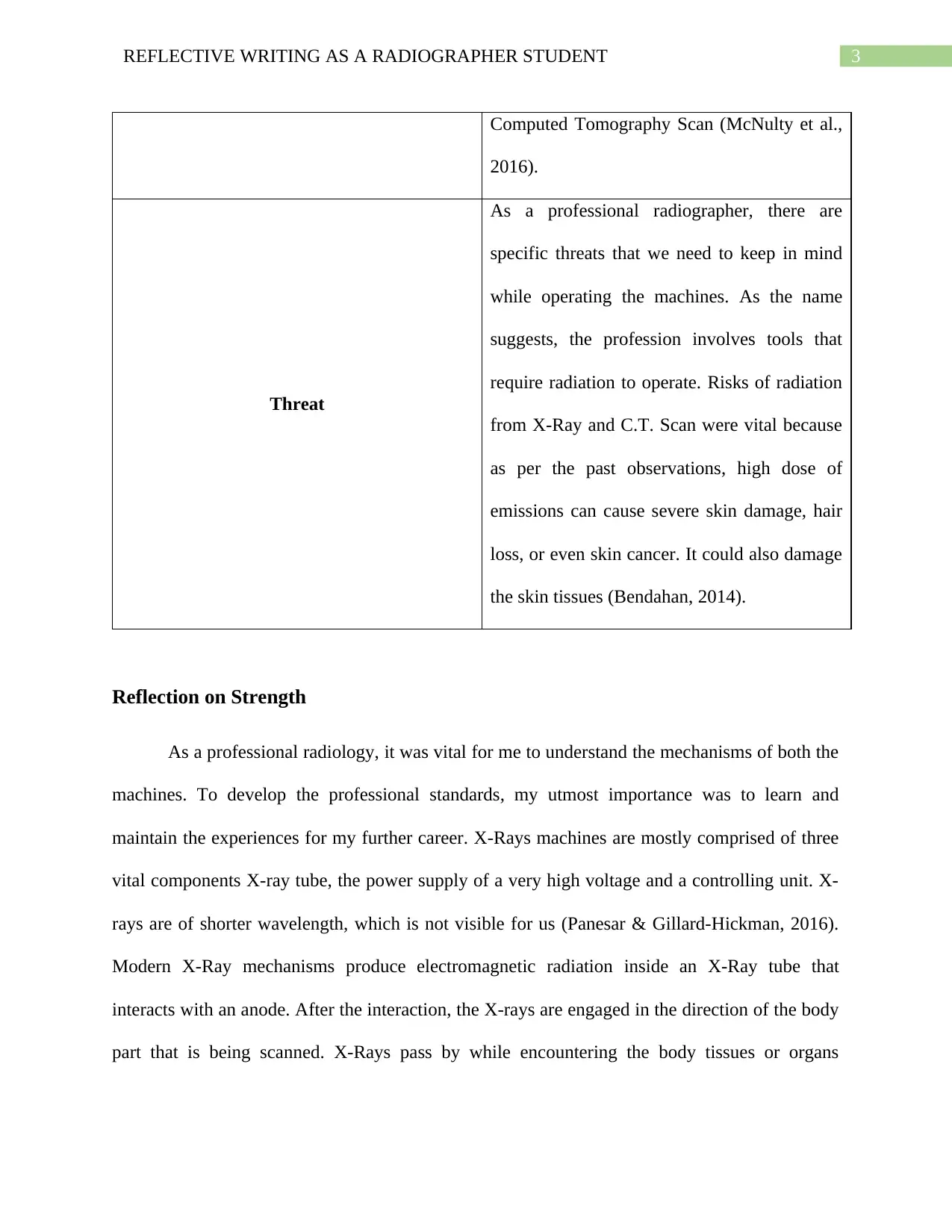
3REFLECTIVE WRITING AS A RADIOGRAPHER STUDENT
Computed Tomography Scan (McNulty et al.,
2016).
Threat
As a professional radiographer, there are
specific threats that we need to keep in mind
while operating the machines. As the name
suggests, the profession involves tools that
require radiation to operate. Risks of radiation
from X-Ray and C.T. Scan were vital because
as per the past observations, high dose of
emissions can cause severe skin damage, hair
loss, or even skin cancer. It could also damage
the skin tissues (Bendahan, 2014).
Reflection on Strength
As a professional radiology, it was vital for me to understand the mechanisms of both the
machines. To develop the professional standards, my utmost importance was to learn and
maintain the experiences for my further career. X-Rays machines are mostly comprised of three
vital components X-ray tube, the power supply of a very high voltage and a controlling unit. X-
rays are of shorter wavelength, which is not visible for us (Panesar & Gillard-Hickman, 2016).
Modern X-Ray mechanisms produce electromagnetic radiation inside an X-Ray tube that
interacts with an anode. After the interaction, the X-rays are engaged in the direction of the body
part that is being scanned. X-Rays pass by while encountering the body tissues or organs
Computed Tomography Scan (McNulty et al.,
2016).
Threat
As a professional radiographer, there are
specific threats that we need to keep in mind
while operating the machines. As the name
suggests, the profession involves tools that
require radiation to operate. Risks of radiation
from X-Ray and C.T. Scan were vital because
as per the past observations, high dose of
emissions can cause severe skin damage, hair
loss, or even skin cancer. It could also damage
the skin tissues (Bendahan, 2014).
Reflection on Strength
As a professional radiology, it was vital for me to understand the mechanisms of both the
machines. To develop the professional standards, my utmost importance was to learn and
maintain the experiences for my further career. X-Rays machines are mostly comprised of three
vital components X-ray tube, the power supply of a very high voltage and a controlling unit. X-
rays are of shorter wavelength, which is not visible for us (Panesar & Gillard-Hickman, 2016).
Modern X-Ray mechanisms produce electromagnetic radiation inside an X-Ray tube that
interacts with an anode. After the interaction, the X-rays are engaged in the direction of the body
part that is being scanned. X-Rays pass by while encountering the body tissues or organs
Secure Best Marks with AI Grader
Need help grading? Try our AI Grader for instant feedback on your assignments.
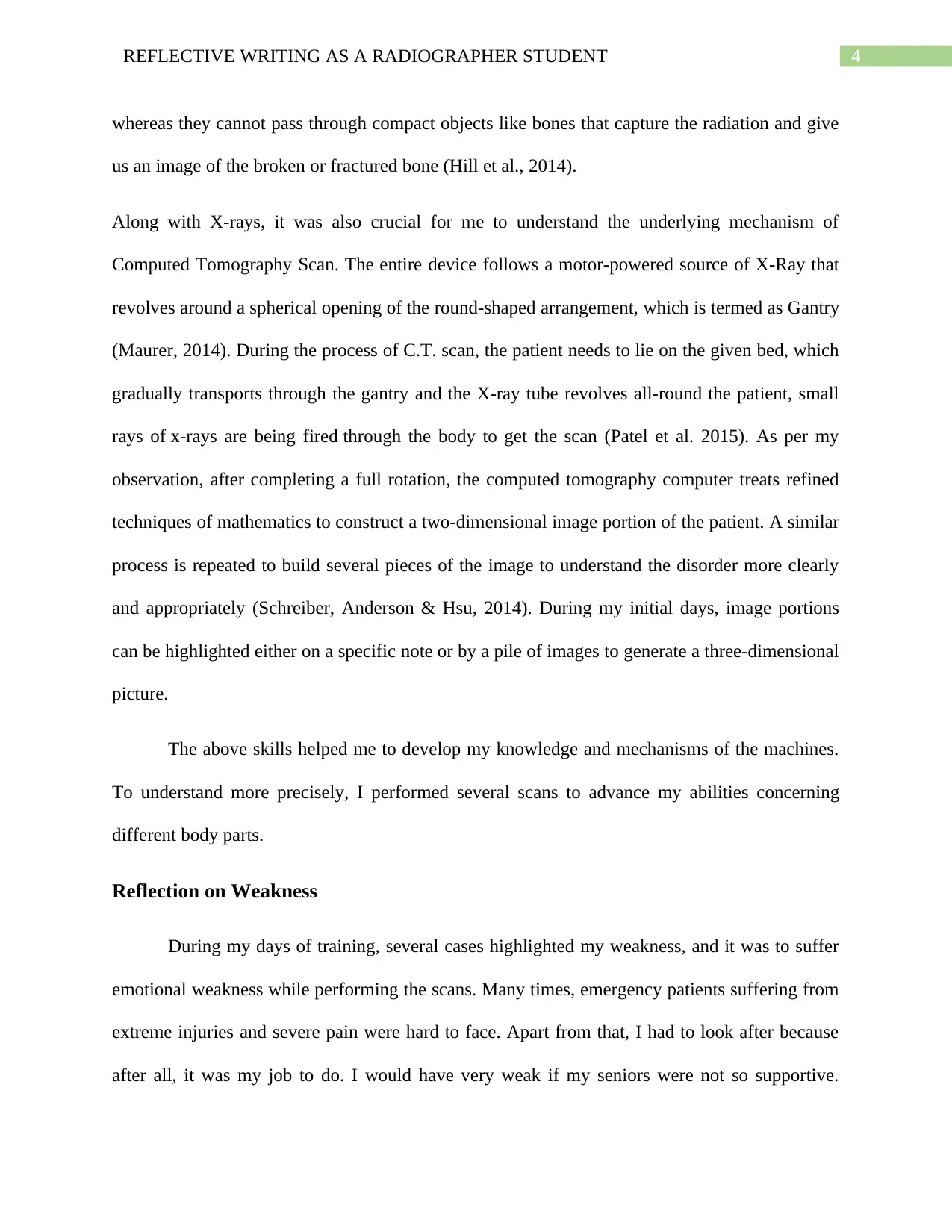
4REFLECTIVE WRITING AS A RADIOGRAPHER STUDENT
whereas they cannot pass through compact objects like bones that capture the radiation and give
us an image of the broken or fractured bone (Hill et al., 2014).
Along with X-rays, it was also crucial for me to understand the underlying mechanism of
Computed Tomography Scan. The entire device follows a motor-powered source of X-Ray that
revolves around a spherical opening of the round-shaped arrangement, which is termed as Gantry
(Maurer, 2014). During the process of C.T. scan, the patient needs to lie on the given bed, which
gradually transports through the gantry and the X-ray tube revolves all-round the patient, small
rays of x-rays are being fired through the body to get the scan (Patel et al. 2015). As per my
observation, after completing a full rotation, the computed tomography computer treats refined
techniques of mathematics to construct a two-dimensional image portion of the patient. A similar
process is repeated to build several pieces of the image to understand the disorder more clearly
and appropriately (Schreiber, Anderson & Hsu, 2014). During my initial days, image portions
can be highlighted either on a specific note or by a pile of images to generate a three-dimensional
picture.
The above skills helped me to develop my knowledge and mechanisms of the machines.
To understand more precisely, I performed several scans to advance my abilities concerning
different body parts.
Reflection on Weakness
During my days of training, several cases highlighted my weakness, and it was to suffer
emotional weakness while performing the scans. Many times, emergency patients suffering from
extreme injuries and severe pain were hard to face. Apart from that, I had to look after because
after all, it was my job to do. I would have very weak if my seniors were not so supportive.
whereas they cannot pass through compact objects like bones that capture the radiation and give
us an image of the broken or fractured bone (Hill et al., 2014).
Along with X-rays, it was also crucial for me to understand the underlying mechanism of
Computed Tomography Scan. The entire device follows a motor-powered source of X-Ray that
revolves around a spherical opening of the round-shaped arrangement, which is termed as Gantry
(Maurer, 2014). During the process of C.T. scan, the patient needs to lie on the given bed, which
gradually transports through the gantry and the X-ray tube revolves all-round the patient, small
rays of x-rays are being fired through the body to get the scan (Patel et al. 2015). As per my
observation, after completing a full rotation, the computed tomography computer treats refined
techniques of mathematics to construct a two-dimensional image portion of the patient. A similar
process is repeated to build several pieces of the image to understand the disorder more clearly
and appropriately (Schreiber, Anderson & Hsu, 2014). During my initial days, image portions
can be highlighted either on a specific note or by a pile of images to generate a three-dimensional
picture.
The above skills helped me to develop my knowledge and mechanisms of the machines.
To understand more precisely, I performed several scans to advance my abilities concerning
different body parts.
Reflection on Weakness
During my days of training, several cases highlighted my weakness, and it was to suffer
emotional weakness while performing the scans. Many times, emergency patients suffering from
extreme injuries and severe pain were hard to face. Apart from that, I had to look after because
after all, it was my job to do. I would have very weak if my seniors were not so supportive.
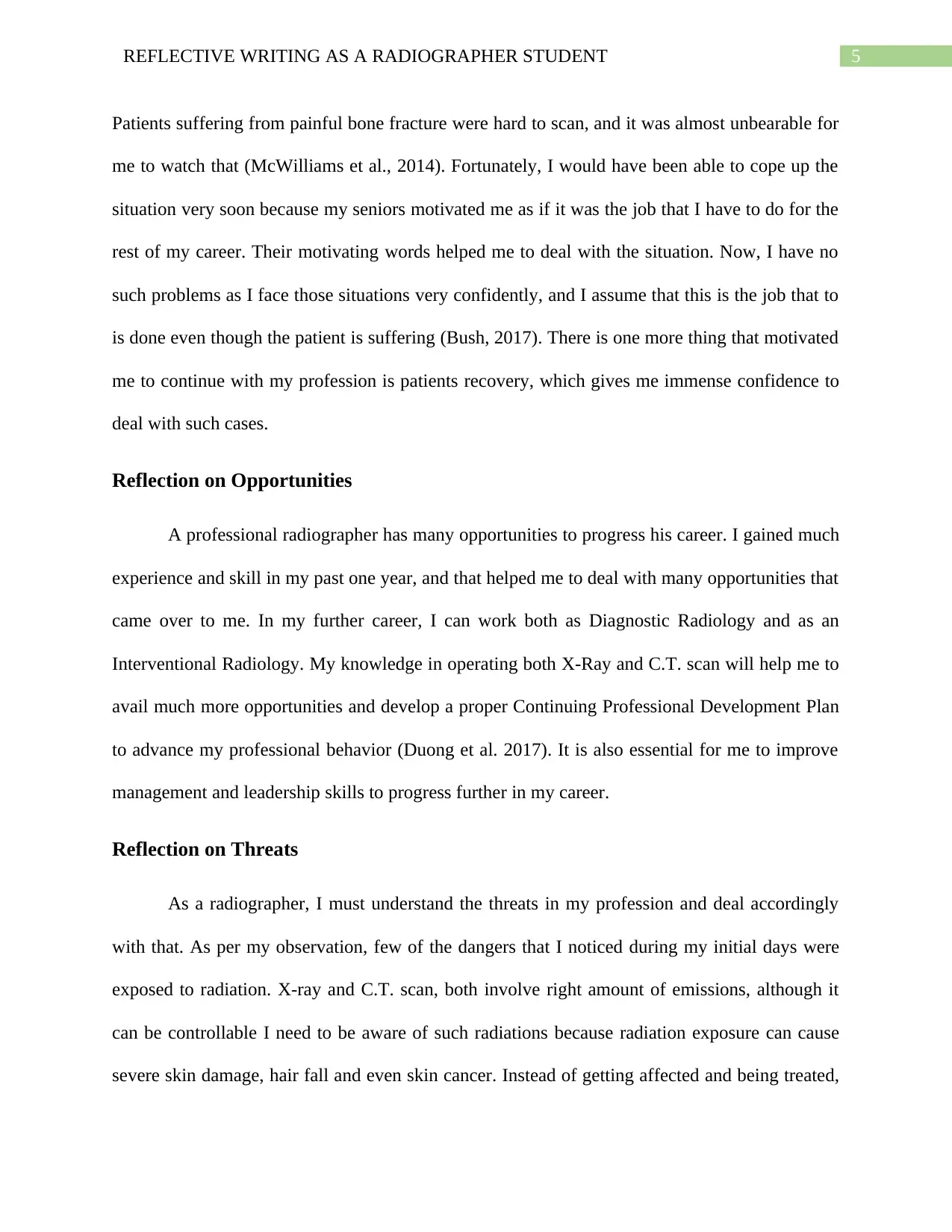
5REFLECTIVE WRITING AS A RADIOGRAPHER STUDENT
Patients suffering from painful bone fracture were hard to scan, and it was almost unbearable for
me to watch that (McWilliams et al., 2014). Fortunately, I would have been able to cope up the
situation very soon because my seniors motivated me as if it was the job that I have to do for the
rest of my career. Their motivating words helped me to deal with the situation. Now, I have no
such problems as I face those situations very confidently, and I assume that this is the job that to
is done even though the patient is suffering (Bush, 2017). There is one more thing that motivated
me to continue with my profession is patients recovery, which gives me immense confidence to
deal with such cases.
Reflection on Opportunities
A professional radiographer has many opportunities to progress his career. I gained much
experience and skill in my past one year, and that helped me to deal with many opportunities that
came over to me. In my further career, I can work both as Diagnostic Radiology and as an
Interventional Radiology. My knowledge in operating both X-Ray and C.T. scan will help me to
avail much more opportunities and develop a proper Continuing Professional Development Plan
to advance my professional behavior (Duong et al. 2017). It is also essential for me to improve
management and leadership skills to progress further in my career.
Reflection on Threats
As a radiographer, I must understand the threats in my profession and deal accordingly
with that. As per my observation, few of the dangers that I noticed during my initial days were
exposed to radiation. X-ray and C.T. scan, both involve right amount of emissions, although it
can be controllable I need to be aware of such radiations because radiation exposure can cause
severe skin damage, hair fall and even skin cancer. Instead of getting affected and being treated,
Patients suffering from painful bone fracture were hard to scan, and it was almost unbearable for
me to watch that (McWilliams et al., 2014). Fortunately, I would have been able to cope up the
situation very soon because my seniors motivated me as if it was the job that I have to do for the
rest of my career. Their motivating words helped me to deal with the situation. Now, I have no
such problems as I face those situations very confidently, and I assume that this is the job that to
is done even though the patient is suffering (Bush, 2017). There is one more thing that motivated
me to continue with my profession is patients recovery, which gives me immense confidence to
deal with such cases.
Reflection on Opportunities
A professional radiographer has many opportunities to progress his career. I gained much
experience and skill in my past one year, and that helped me to deal with many opportunities that
came over to me. In my further career, I can work both as Diagnostic Radiology and as an
Interventional Radiology. My knowledge in operating both X-Ray and C.T. scan will help me to
avail much more opportunities and develop a proper Continuing Professional Development Plan
to advance my professional behavior (Duong et al. 2017). It is also essential for me to improve
management and leadership skills to progress further in my career.
Reflection on Threats
As a radiographer, I must understand the threats in my profession and deal accordingly
with that. As per my observation, few of the dangers that I noticed during my initial days were
exposed to radiation. X-ray and C.T. scan, both involve right amount of emissions, although it
can be controllable I need to be aware of such radiations because radiation exposure can cause
severe skin damage, hair fall and even skin cancer. Instead of getting affected and being treated,
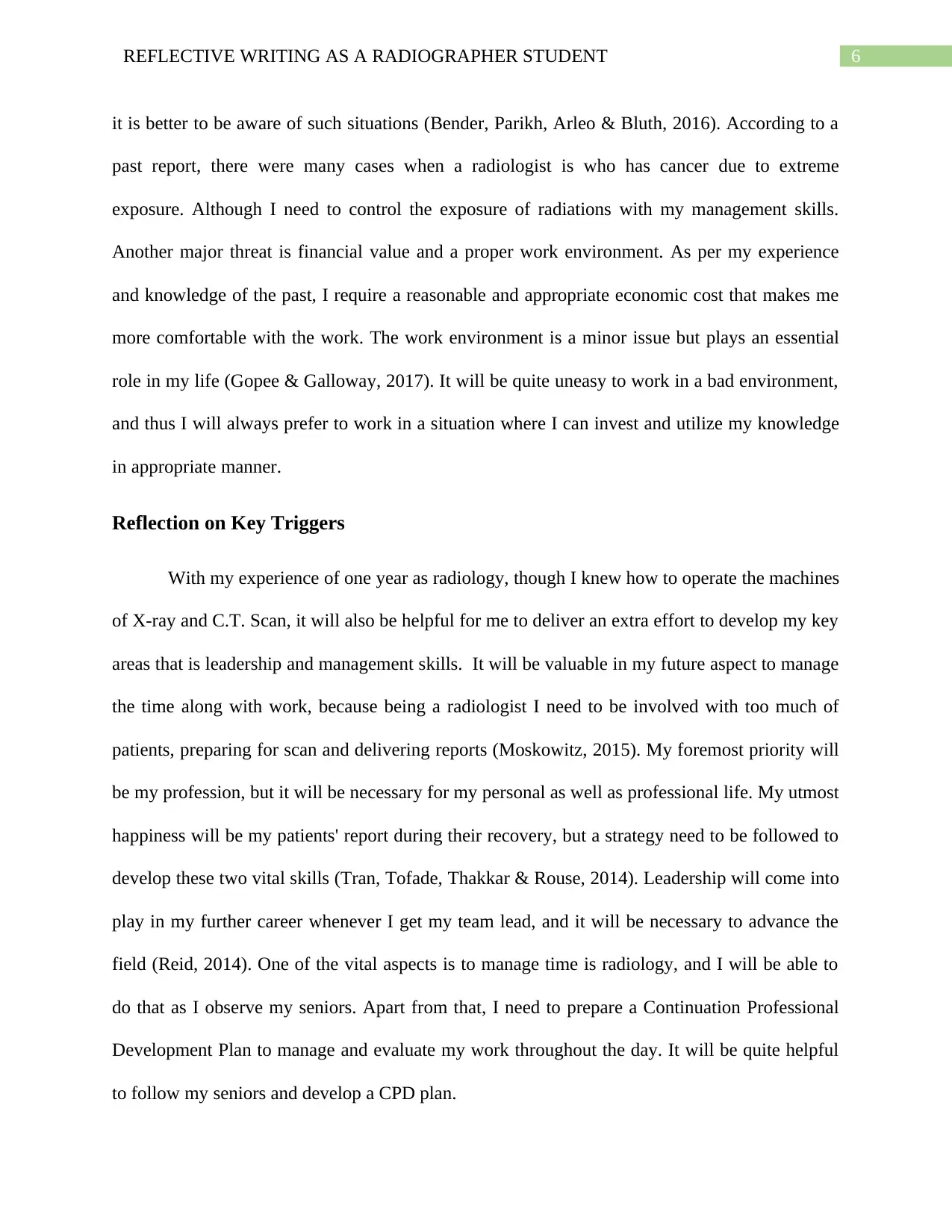
6REFLECTIVE WRITING AS A RADIOGRAPHER STUDENT
it is better to be aware of such situations (Bender, Parikh, Arleo & Bluth, 2016). According to a
past report, there were many cases when a radiologist is who has cancer due to extreme
exposure. Although I need to control the exposure of radiations with my management skills.
Another major threat is financial value and a proper work environment. As per my experience
and knowledge of the past, I require a reasonable and appropriate economic cost that makes me
more comfortable with the work. The work environment is a minor issue but plays an essential
role in my life (Gopee & Galloway, 2017). It will be quite uneasy to work in a bad environment,
and thus I will always prefer to work in a situation where I can invest and utilize my knowledge
in appropriate manner.
Reflection on Key Triggers
With my experience of one year as radiology, though I knew how to operate the machines
of X-ray and C.T. Scan, it will also be helpful for me to deliver an extra effort to develop my key
areas that is leadership and management skills. It will be valuable in my future aspect to manage
the time along with work, because being a radiologist I need to be involved with too much of
patients, preparing for scan and delivering reports (Moskowitz, 2015). My foremost priority will
be my profession, but it will be necessary for my personal as well as professional life. My utmost
happiness will be my patients' report during their recovery, but a strategy need to be followed to
develop these two vital skills (Tran, Tofade, Thakkar & Rouse, 2014). Leadership will come into
play in my further career whenever I get my team lead, and it will be necessary to advance the
field (Reid, 2014). One of the vital aspects is to manage time is radiology, and I will be able to
do that as I observe my seniors. Apart from that, I need to prepare a Continuation Professional
Development Plan to manage and evaluate my work throughout the day. It will be quite helpful
to follow my seniors and develop a CPD plan.
it is better to be aware of such situations (Bender, Parikh, Arleo & Bluth, 2016). According to a
past report, there were many cases when a radiologist is who has cancer due to extreme
exposure. Although I need to control the exposure of radiations with my management skills.
Another major threat is financial value and a proper work environment. As per my experience
and knowledge of the past, I require a reasonable and appropriate economic cost that makes me
more comfortable with the work. The work environment is a minor issue but plays an essential
role in my life (Gopee & Galloway, 2017). It will be quite uneasy to work in a bad environment,
and thus I will always prefer to work in a situation where I can invest and utilize my knowledge
in appropriate manner.
Reflection on Key Triggers
With my experience of one year as radiology, though I knew how to operate the machines
of X-ray and C.T. Scan, it will also be helpful for me to deliver an extra effort to develop my key
areas that is leadership and management skills. It will be valuable in my future aspect to manage
the time along with work, because being a radiologist I need to be involved with too much of
patients, preparing for scan and delivering reports (Moskowitz, 2015). My foremost priority will
be my profession, but it will be necessary for my personal as well as professional life. My utmost
happiness will be my patients' report during their recovery, but a strategy need to be followed to
develop these two vital skills (Tran, Tofade, Thakkar & Rouse, 2014). Leadership will come into
play in my further career whenever I get my team lead, and it will be necessary to advance the
field (Reid, 2014). One of the vital aspects is to manage time is radiology, and I will be able to
do that as I observe my seniors. Apart from that, I need to prepare a Continuation Professional
Development Plan to manage and evaluate my work throughout the day. It will be quite helpful
to follow my seniors and develop a CPD plan.
Paraphrase This Document
Need a fresh take? Get an instant paraphrase of this document with our AI Paraphraser

7REFLECTIVE WRITING AS A RADIOGRAPHER STUDENT
Strategic CPD Plan
Being a radiologist, X-ray, and C.T. scan will not be my only task to perform on a daily
basis. I need to manage my professional as well as personal life similarly, and for that, I need to
have a proper strategic Continuation Professional Development Plan. For further progress, along
with my one-year knowledge and skills of radiologist, I need to flourish myself with proper CPD
Plan (Smith, Latter & Blenkinsopp, 2014). A proper CPD plan will help me to grow with two of
the vital skills, leadership, and management. In order to develop such, I need to follow my
seniors as if they manage themselves. The only time when I will able to know that I learned
those when I would be distributing my work with proper understanding. My CPD plan will
revolve around my personal development, along with my professional development. It will also
be essential for me to gain knowledge as much as possible in my field (Henwood & Flinton,
2017). As a radiologist, there will be further developed in the career, staying updated with the
recent improvements will also be a crucial aspect in my CPD plan. As per my CPD plan,
knowledge will be something that will try to gain as long as possible because to stay updated is
very important as per the future aspect.
Resources and Assistance
Resources and assistance are the vital aspects of a Radiologist. According to me, it will
comprise of several parts of both the machines. Several shreds of evidence support that x-ray
devices include an x-ray tube, power supply of high voltage and a controller (Ng et al., 2015). It
also needs a separate machine to generate the images and take a hard copy of that. As per as my
days of training, there are two types of radiography, Indirect Digital Radiography, and Direct
Digital Radiography. I would suggest a room to be considered dust-free because soils might
Strategic CPD Plan
Being a radiologist, X-ray, and C.T. scan will not be my only task to perform on a daily
basis. I need to manage my professional as well as personal life similarly, and for that, I need to
have a proper strategic Continuation Professional Development Plan. For further progress, along
with my one-year knowledge and skills of radiologist, I need to flourish myself with proper CPD
Plan (Smith, Latter & Blenkinsopp, 2014). A proper CPD plan will help me to grow with two of
the vital skills, leadership, and management. In order to develop such, I need to follow my
seniors as if they manage themselves. The only time when I will able to know that I learned
those when I would be distributing my work with proper understanding. My CPD plan will
revolve around my personal development, along with my professional development. It will also
be essential for me to gain knowledge as much as possible in my field (Henwood & Flinton,
2017). As a radiologist, there will be further developed in the career, staying updated with the
recent improvements will also be a crucial aspect in my CPD plan. As per my CPD plan,
knowledge will be something that will try to gain as long as possible because to stay updated is
very important as per the future aspect.
Resources and Assistance
Resources and assistance are the vital aspects of a Radiologist. According to me, it will
comprise of several parts of both the machines. Several shreds of evidence support that x-ray
devices include an x-ray tube, power supply of high voltage and a controller (Ng et al., 2015). It
also needs a separate machine to generate the images and take a hard copy of that. As per as my
days of training, there are two types of radiography, Indirect Digital Radiography, and Direct
Digital Radiography. I would suggest a room to be considered dust-free because soils might

8REFLECTIVE WRITING AS A RADIOGRAPHER STUDENT
affect the imaging process. Inclusion of proper lights needs to be taken care because views are
essential to process images with utmost importance.
Conclusion
Lastly, I would like to conclude from the above writing that radiology being an important
profession requires not only proper knowledge about X-ray and C.T. scan machines but also
requires skillful knowledge about time management and leadership. As per my observation, it is
a profession, which requires the utmost focus and concentration. With a minor mistake in the
report can cause considerable havoc in the patient. Before getting involved in the operating
section, it was vital for me to detect the mechanism of both the machines. My primary focus will
be to beware of the radiations from the computers because a minor exposure to emissions can
cause a mass impact in the body. Therefore, X-ray and C.T. scan, both are vital tools in the
medical field and are used to detect numerous fractures, diseases, and even cancers. Moreover,
radiologist also suffers from some form of emotional weakness as I faced during my initial days,
but it needs to overcome as early as possible because facing pain and injuries will be regular for
a professional radiologist.
affect the imaging process. Inclusion of proper lights needs to be taken care because views are
essential to process images with utmost importance.
Conclusion
Lastly, I would like to conclude from the above writing that radiology being an important
profession requires not only proper knowledge about X-ray and C.T. scan machines but also
requires skillful knowledge about time management and leadership. As per my observation, it is
a profession, which requires the utmost focus and concentration. With a minor mistake in the
report can cause considerable havoc in the patient. Before getting involved in the operating
section, it was vital for me to detect the mechanism of both the machines. My primary focus will
be to beware of the radiations from the computers because a minor exposure to emissions can
cause a mass impact in the body. Therefore, X-ray and C.T. scan, both are vital tools in the
medical field and are used to detect numerous fractures, diseases, and even cancers. Moreover,
radiologist also suffers from some form of emotional weakness as I faced during my initial days,
but it needs to overcome as early as possible because facing pain and injuries will be regular for
a professional radiologist.
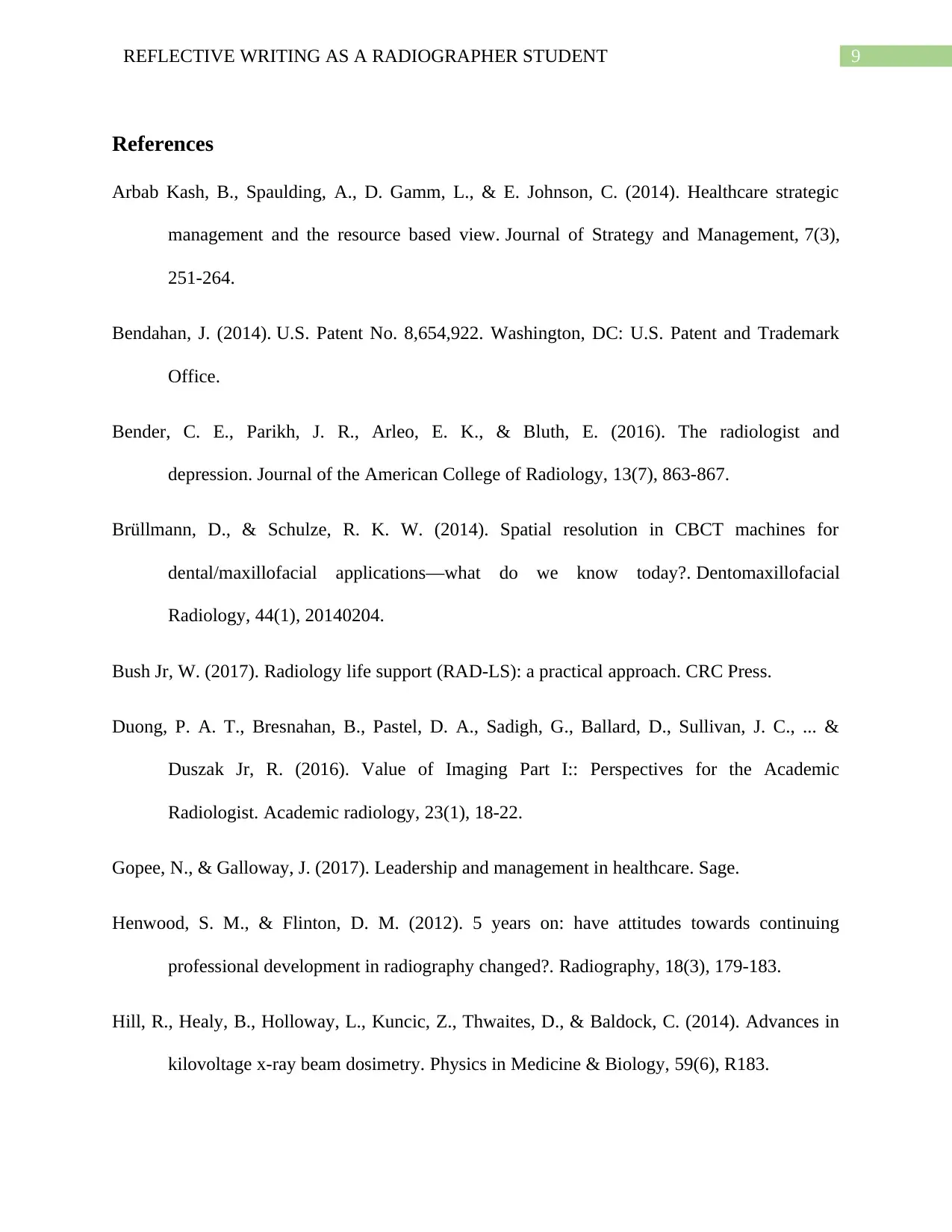
9REFLECTIVE WRITING AS A RADIOGRAPHER STUDENT
References
Arbab Kash, B., Spaulding, A., D. Gamm, L., & E. Johnson, C. (2014). Healthcare strategic
management and the resource based view. Journal of Strategy and Management, 7(3),
251-264.
Bendahan, J. (2014). U.S. Patent No. 8,654,922. Washington, DC: U.S. Patent and Trademark
Office.
Bender, C. E., Parikh, J. R., Arleo, E. K., & Bluth, E. (2016). The radiologist and
depression. Journal of the American College of Radiology, 13(7), 863-867.
Brüllmann, D., & Schulze, R. K. W. (2014). Spatial resolution in CBCT machines for
dental/maxillofacial applications—what do we know today?. Dentomaxillofacial
Radiology, 44(1), 20140204.
Bush Jr, W. (2017). Radiology life support (RAD-LS): a practical approach. CRC Press.
Duong, P. A. T., Bresnahan, B., Pastel, D. A., Sadigh, G., Ballard, D., Sullivan, J. C., ... &
Duszak Jr, R. (2016). Value of Imaging Part I:: Perspectives for the Academic
Radiologist. Academic radiology, 23(1), 18-22.
Gopee, N., & Galloway, J. (2017). Leadership and management in healthcare. Sage.
Henwood, S. M., & Flinton, D. M. (2012). 5 years on: have attitudes towards continuing
professional development in radiography changed?. Radiography, 18(3), 179-183.
Hill, R., Healy, B., Holloway, L., Kuncic, Z., Thwaites, D., & Baldock, C. (2014). Advances in
kilovoltage x-ray beam dosimetry. Physics in Medicine & Biology, 59(6), R183.
References
Arbab Kash, B., Spaulding, A., D. Gamm, L., & E. Johnson, C. (2014). Healthcare strategic
management and the resource based view. Journal of Strategy and Management, 7(3),
251-264.
Bendahan, J. (2014). U.S. Patent No. 8,654,922. Washington, DC: U.S. Patent and Trademark
Office.
Bender, C. E., Parikh, J. R., Arleo, E. K., & Bluth, E. (2016). The radiologist and
depression. Journal of the American College of Radiology, 13(7), 863-867.
Brüllmann, D., & Schulze, R. K. W. (2014). Spatial resolution in CBCT machines for
dental/maxillofacial applications—what do we know today?. Dentomaxillofacial
Radiology, 44(1), 20140204.
Bush Jr, W. (2017). Radiology life support (RAD-LS): a practical approach. CRC Press.
Duong, P. A. T., Bresnahan, B., Pastel, D. A., Sadigh, G., Ballard, D., Sullivan, J. C., ... &
Duszak Jr, R. (2016). Value of Imaging Part I:: Perspectives for the Academic
Radiologist. Academic radiology, 23(1), 18-22.
Gopee, N., & Galloway, J. (2017). Leadership and management in healthcare. Sage.
Henwood, S. M., & Flinton, D. M. (2012). 5 years on: have attitudes towards continuing
professional development in radiography changed?. Radiography, 18(3), 179-183.
Hill, R., Healy, B., Holloway, L., Kuncic, Z., Thwaites, D., & Baldock, C. (2014). Advances in
kilovoltage x-ray beam dosimetry. Physics in Medicine & Biology, 59(6), R183.
Secure Best Marks with AI Grader
Need help grading? Try our AI Grader for instant feedback on your assignments.
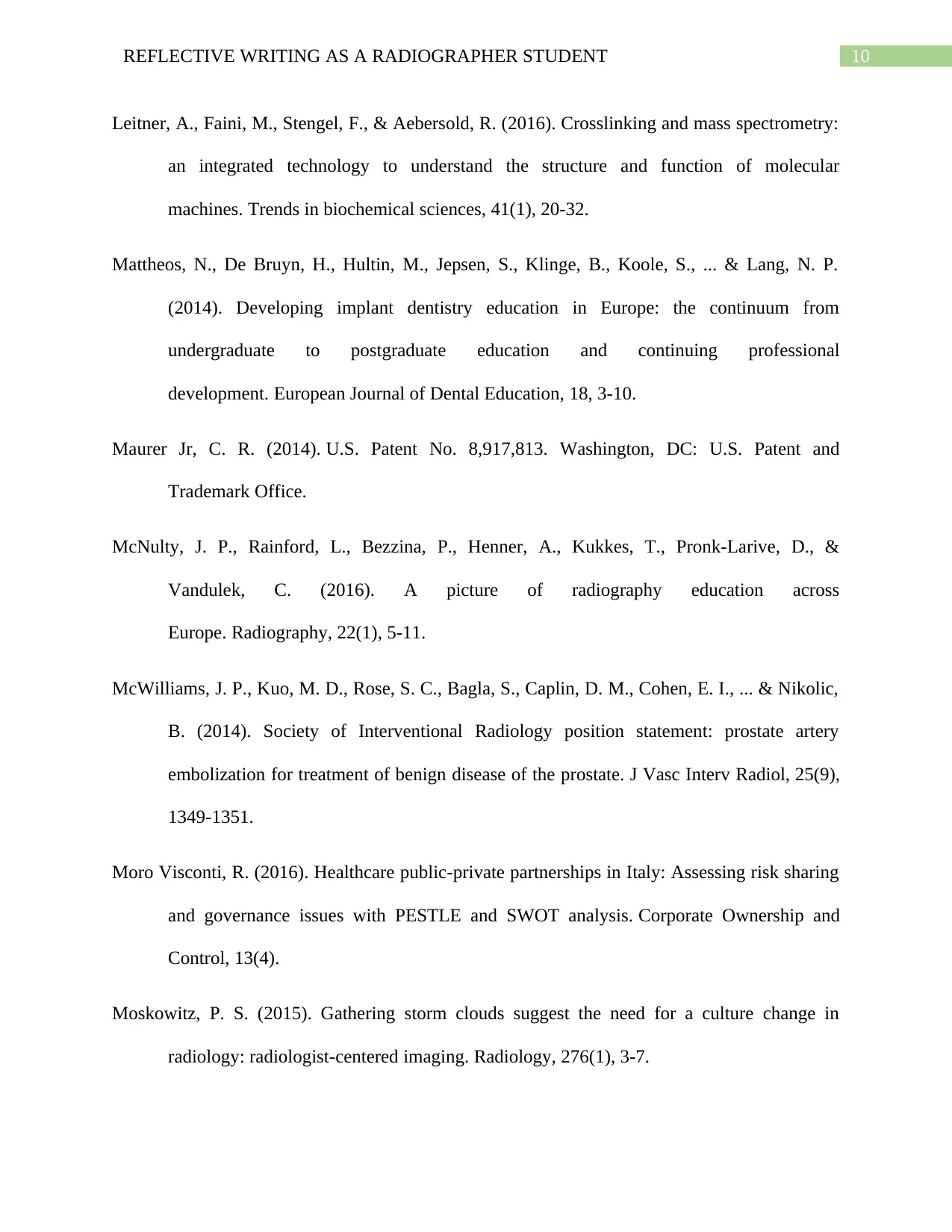
10REFLECTIVE WRITING AS A RADIOGRAPHER STUDENT
Leitner, A., Faini, M., Stengel, F., & Aebersold, R. (2016). Crosslinking and mass spectrometry:
an integrated technology to understand the structure and function of molecular
machines. Trends in biochemical sciences, 41(1), 20-32.
Mattheos, N., De Bruyn, H., Hultin, M., Jepsen, S., Klinge, B., Koole, S., ... & Lang, N. P.
(2014). Developing implant dentistry education in Europe: the continuum from
undergraduate to postgraduate education and continuing professional
development. European Journal of Dental Education, 18, 3-10.
Maurer Jr, C. R. (2014). U.S. Patent No. 8,917,813. Washington, DC: U.S. Patent and
Trademark Office.
McNulty, J. P., Rainford, L., Bezzina, P., Henner, A., Kukkes, T., Pronk-Larive, D., &
Vandulek, C. (2016). A picture of radiography education across
Europe. Radiography, 22(1), 5-11.
McWilliams, J. P., Kuo, M. D., Rose, S. C., Bagla, S., Caplin, D. M., Cohen, E. I., ... & Nikolic,
B. (2014). Society of Interventional Radiology position statement: prostate artery
embolization for treatment of benign disease of the prostate. J Vasc Interv Radiol, 25(9),
1349-1351.
Moro Visconti, R. (2016). Healthcare public-private partnerships in Italy: Assessing risk sharing
and governance issues with PESTLE and SWOT analysis. Corporate Ownership and
Control, 13(4).
Moskowitz, P. S. (2015). Gathering storm clouds suggest the need for a culture change in
radiology: radiologist-centered imaging. Radiology, 276(1), 3-7.
Leitner, A., Faini, M., Stengel, F., & Aebersold, R. (2016). Crosslinking and mass spectrometry:
an integrated technology to understand the structure and function of molecular
machines. Trends in biochemical sciences, 41(1), 20-32.
Mattheos, N., De Bruyn, H., Hultin, M., Jepsen, S., Klinge, B., Koole, S., ... & Lang, N. P.
(2014). Developing implant dentistry education in Europe: the continuum from
undergraduate to postgraduate education and continuing professional
development. European Journal of Dental Education, 18, 3-10.
Maurer Jr, C. R. (2014). U.S. Patent No. 8,917,813. Washington, DC: U.S. Patent and
Trademark Office.
McNulty, J. P., Rainford, L., Bezzina, P., Henner, A., Kukkes, T., Pronk-Larive, D., &
Vandulek, C. (2016). A picture of radiography education across
Europe. Radiography, 22(1), 5-11.
McWilliams, J. P., Kuo, M. D., Rose, S. C., Bagla, S., Caplin, D. M., Cohen, E. I., ... & Nikolic,
B. (2014). Society of Interventional Radiology position statement: prostate artery
embolization for treatment of benign disease of the prostate. J Vasc Interv Radiol, 25(9),
1349-1351.
Moro Visconti, R. (2016). Healthcare public-private partnerships in Italy: Assessing risk sharing
and governance issues with PESTLE and SWOT analysis. Corporate Ownership and
Control, 13(4).
Moskowitz, P. S. (2015). Gathering storm clouds suggest the need for a culture change in
radiology: radiologist-centered imaging. Radiology, 276(1), 3-7.
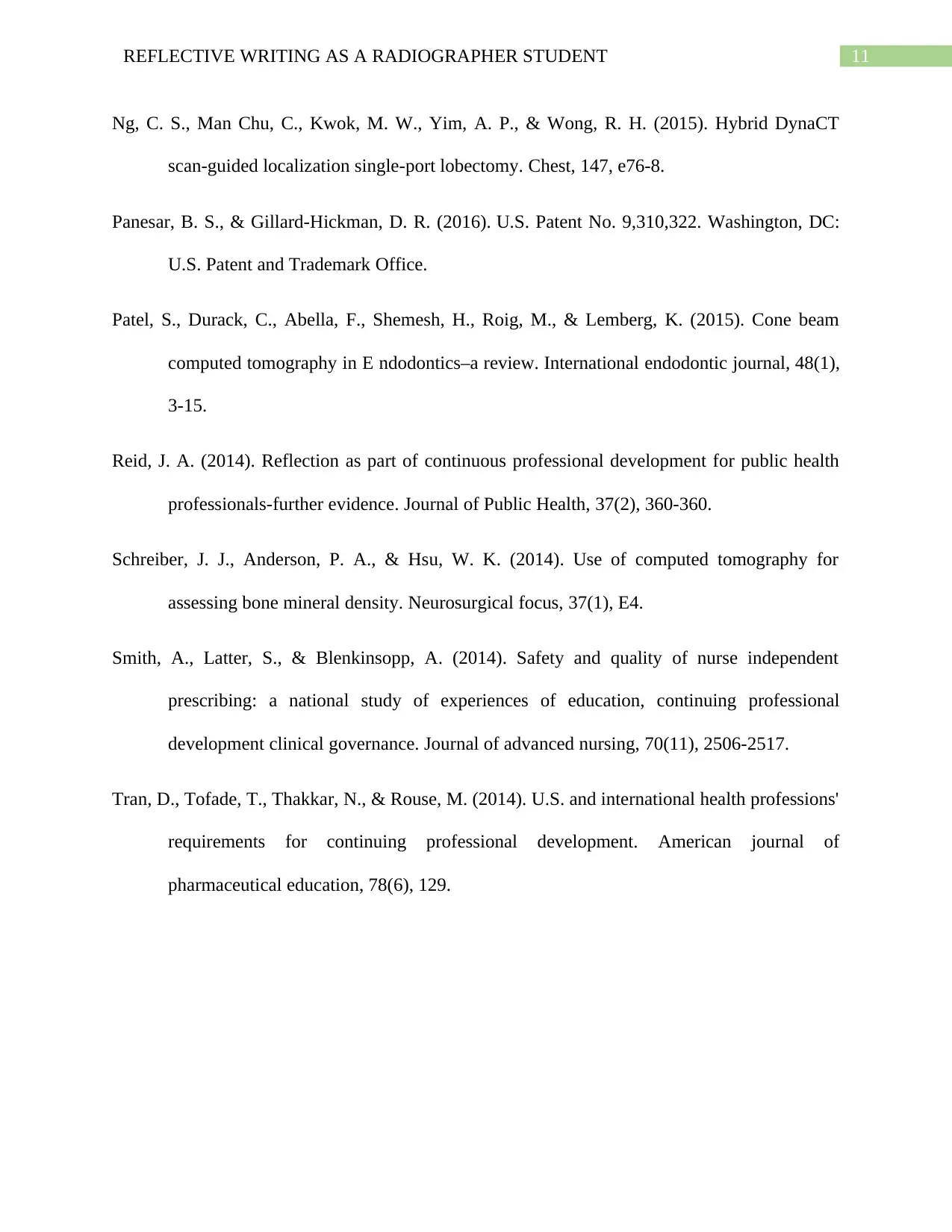
11REFLECTIVE WRITING AS A RADIOGRAPHER STUDENT
Ng, C. S., Man Chu, C., Kwok, M. W., Yim, A. P., & Wong, R. H. (2015). Hybrid DynaCT
scan-guided localization single-port lobectomy. Chest, 147, e76-8.
Panesar, B. S., & Gillard-Hickman, D. R. (2016). U.S. Patent No. 9,310,322. Washington, DC:
U.S. Patent and Trademark Office.
Patel, S., Durack, C., Abella, F., Shemesh, H., Roig, M., & Lemberg, K. (2015). Cone beam
computed tomography in E ndodontics–a review. International endodontic journal, 48(1),
3-15.
Reid, J. A. (2014). Reflection as part of continuous professional development for public health
professionals-further evidence. Journal of Public Health, 37(2), 360-360.
Schreiber, J. J., Anderson, P. A., & Hsu, W. K. (2014). Use of computed tomography for
assessing bone mineral density. Neurosurgical focus, 37(1), E4.
Smith, A., Latter, S., & Blenkinsopp, A. (2014). Safety and quality of nurse independent
prescribing: a national study of experiences of education, continuing professional
development clinical governance. Journal of advanced nursing, 70(11), 2506-2517.
Tran, D., Tofade, T., Thakkar, N., & Rouse, M. (2014). U.S. and international health professions'
requirements for continuing professional development. American journal of
pharmaceutical education, 78(6), 129.
Ng, C. S., Man Chu, C., Kwok, M. W., Yim, A. P., & Wong, R. H. (2015). Hybrid DynaCT
scan-guided localization single-port lobectomy. Chest, 147, e76-8.
Panesar, B. S., & Gillard-Hickman, D. R. (2016). U.S. Patent No. 9,310,322. Washington, DC:
U.S. Patent and Trademark Office.
Patel, S., Durack, C., Abella, F., Shemesh, H., Roig, M., & Lemberg, K. (2015). Cone beam
computed tomography in E ndodontics–a review. International endodontic journal, 48(1),
3-15.
Reid, J. A. (2014). Reflection as part of continuous professional development for public health
professionals-further evidence. Journal of Public Health, 37(2), 360-360.
Schreiber, J. J., Anderson, P. A., & Hsu, W. K. (2014). Use of computed tomography for
assessing bone mineral density. Neurosurgical focus, 37(1), E4.
Smith, A., Latter, S., & Blenkinsopp, A. (2014). Safety and quality of nurse independent
prescribing: a national study of experiences of education, continuing professional
development clinical governance. Journal of advanced nursing, 70(11), 2506-2517.
Tran, D., Tofade, T., Thakkar, N., & Rouse, M. (2014). U.S. and international health professions'
requirements for continuing professional development. American journal of
pharmaceutical education, 78(6), 129.
1 out of 12
Related Documents
Your All-in-One AI-Powered Toolkit for Academic Success.
+13062052269
info@desklib.com
Available 24*7 on WhatsApp / Email
![[object Object]](/_next/static/media/star-bottom.7253800d.svg)
Unlock your academic potential
© 2024 | Zucol Services PVT LTD | All rights reserved.




